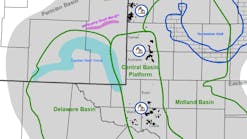Kamal M. Morsi
Abu Dhabi National Oil Co.
Abu Dhabi
Upgrade of the Umm Shaif gas project, commissioned last November, will increase the number of gas-producing wells and boost gas production to 1,045 from 400 MMscfd. This production rate will meet Abu Dhabi Gas Liquefaction Co. Ltd.'s (Adgas) requirements for the its new third LNG train on Das Island.
To reach the higher production level, Abu Dhabi National Oil Co. (Adnoc) applied a variety of modern technology and techniques at Umm Shaif field.
UMM SHAIF PRODUCTION
The Umm Shaif field is in the central part of the Arabian Gulf, about 135 km (92 miles) northwest of Abu Dhabi City and 35 km (22 miles) east of Das Island where the oil and gas are treated and exported.
The Umm Shaif field, discovered in 1958, went on stream in June 1962. Commercial oil and gas accumulations were proved in a number of different formations, namely the Arab D, Araej, Uweinat, Khuff, and the upper part of the Thamama group.
FIELD UPGRADE
The main objectives of the Umm Shaif field upgrade were to:
- Meet Adgas additional requirements for gas supply to the new third LNG train.
- Generate additional revenues for Adnoc through the production and sale of condensate, natural gas liquids (NGL), and sulfur.
- Prolong the life of the field and enhance oil recovery by providing sufficient gas injection for reservoir pressure maintenance of oil and gas reservoirs such as into the Arab D, Thamama, Uweinat, and Upper Araej formations.
As part of the gas development project, the number of gas-producing wells in the Umm Shaif field was increased to raise the gas production capacity. The extra wells were drilled from three new wellhead platforms, NT-4, NT-1 and NT-3, and two of the existing wellhead platforms (Fig. 1)(77222 bytes).
For gas gathering, new 18-in. and 24-in. flow lines were installed between the new gas treatment platform (NGTP) at the Umm Shaif super complex (USSC) and the three new wellhead platforms. In addition, a fourth new flow line was installed to tie in gas wells on one of the existing wellhead platforms.
Gas received from the wellhead platforms via the new flow lines is separated from condensate and dehydrated at the new gas treatment platform. A bridge links the new platform to the USSC complex (Fig. 2). The gas dehydration capacity of the NGTP is 660 MMscfd.
Dehydrated gas is sent to Das Island via the newly installed 46-in. main gas line. Condensate is transferred to Das Island through an existing 18-in. condensate line.
At Das Island, the gas is treated in the existing condensate treatment unit (CTU) before being delivered to Adgas. The CTU on Das Island was upgraded to handle the additional volume. Condensate is stabilized in existing cascade flash separators that also were upgraded. The condensate is sweetened in a new facility and stored in an existing tank on Das Island.
The scope of work comprises the installation of new facilities and plant modifications as follows:
- Drilling and completion of 14 gas producers and injectors wells
- Three new wellhead platforms NT1, NT3, and NT4
- Modification of the four existing wellhead platforms US-88, US-109, US-116, and US-120
- Four new flow lines l New gas treatment platform
- Existing facilities USSC modifications
- New 46-in. main gas line
- Modifications to the gas and condensate treatment facilities on Das Island.
PROJECT IMPLEMENTATION
The exploration and production directorate of Adnoc applied various modern techniques and technologies for implementing the upstream part of the project that included the wellhead platforms, wells, gas injection, gas gathering system, and gas treatment plants.
A new production/injection technique was implemented to produce high-pressure Khuff dry gas and inject it into Uweinat Cap gas reservoir automatically without expensive mechanical means.
Producing and injection wells are situated on the same offshore platform structure with minimum control facilities/equipment and less capital/operating costs.
The objective of gas injection is to maintain reservoir pressure, prolong the life of the reservoir, and enhance condensate recovery.
Solar systems provide power for telemetry, fire and gas detection, and chemical injection systems.
Because of the high hydrogen sulfide and carbon dioxide content, the gas wells are completed with corrosion-resistant alloy (CRA) tubing and cladded christmas trees. This precludes the need for downhole inhibitor injection.
Wells are provided with downhole safety valves to protect them during emergencies such as blowouts, leaks, or fires.
The new main gas line is provided with a pig launcher and receiver to permit running of instrumented/intelligent pigs to check pipeline integrity.
Data acquisition is achieved via telemetry links to the Umm Shaif control room. Such data include flow condition measurements, valve position, alarm condition, remote signal operation of production valves, pipeline pressure, and pipeline temperature.
Since commissioning the project, the system has operated safety and efficiently.
Copyright 1995 Oil & Gas Journal. All Rights Reserved.




